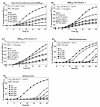Chemical Profile and Antimicrobial Activity of the Fungus-Growing Termite Strain Macrotermes Bellicosus Used in Traditional Medicine in the Republic of Benin
- PMID: 33138110
- PMCID: PMC7662623
- DOI: 10.3390/molecules25215015
Chemical Profile and Antimicrobial Activity of the Fungus-Growing Termite Strain Macrotermes Bellicosus Used in Traditional Medicine in the Republic of Benin
Abstract
The fungus growing termite species Macrotermes bellicosus (M. bellicosus) is used in nutrition and traditional medicine in the Republic of Benin for the treatment of infectious and inflammatory diseases. Previous findings demonstrated evidence of anti-inflammatory and spasmolytic properties of M. bellicosus. The aim of the present study was to evaluate the antimicrobial potential of different extracts of M. bellicosus samples and determine the chemical profile of an ethanolic M. bellicosus extract. Chemical profiling was conducted using centrifugal partition chromatography and 13C-NMR, followed by MALDI-TOF MS. Major identified compounds include hydroquinone (HQ), methylhydroquinone (MHQ), 3,4-dihydroxyphenethyl glycol (DHPG), N-acetyldopamine (NADA) and niacinamide. The fatty acid mixture of the extract was mainly composed of linoleic and oleic acid and highlights the nutritional purpose of M. bellicosus. Using the Kirby-Bauer disc diffusion and broth microdilution assay, an antibacterial activity of M. bellicosus samples was observed against various clinical strains with a highest growth inhibition of S. aureus. In addition, HQ and MHQ as well as fractions containing DHPG, niacinamide and NADA inhibited S. aureus growth. The reported antimicrobial activity of M. bellicosus and identified active substances provide a rationale for the traditional medicinal use of M. bellicosus.
Keywords: Macrotermes bellicosus; Republic of Benin; antibacterial activity; hydroquinone; methylhydroquinone; termite; traditional medicine.
Conflict of interest statement
The authors declare that first author Dima Hammoud Mahdi received financial support for mobility via the Dr. Willmar Schwabe Research Scholarship (2017) from Dr. Willmar Schwabe GmbH & Co. KG. The funder was not involved in the study design, collection, analyses, interpretation of data, the writing of this article or the decision to submit it for publication. Author Jane Hubert was employed by the company NatExplore SAS and author Cica Vissiennon was employed by the company Repha GmbH Biologische Arzneimittel. The remaining authors declare that the research was conducted in the absence of any commercial or financial relationships that could be construed as a potential conflict of interest.
Figures



Similar articles
-
Ethnomedicinal survey and in vitro confirmation of anti-inflammatory and antispasmodic properties of the termite strain Macrotermes bellicosus used in traditional medicine in the Republic of Benin.J Ethnopharmacol. 2020 May 23;254:112705. doi: 10.1016/j.jep.2020.112705. Epub 2020 Feb 22. J Ethnopharmacol. 2020. PMID: 32097700
-
Volatile Organic Compounds of Diverse Origins and Their Changes Associated With Cultivar Decay in a Fungus-Farming Termite.Environ Microbiol. 2025 Feb;27(2):e70049. doi: 10.1111/1462-2920.70049. Environ Microbiol. 2025. PMID: 39910670 Free PMC article.
-
Antimicrobial activities of fungus comb extracts isolated from Indomalayan termite (Macrotermes gilvus Hagen) mound.AMB Express. 2022 Feb 10;12(1):14. doi: 10.1186/s13568-022-01359-0. AMB Express. 2022. PMID: 35142937 Free PMC article.
-
Usnea sp.: Antimicrobial potential, bioactive compounds, ethnopharmacological uses and other pharmacological properties; a review article.J Ethnopharmacol. 2021 Mar 25;268:113656. doi: 10.1016/j.jep.2020.113656. Epub 2020 Dec 1. J Ethnopharmacol. 2021. PMID: 33276059 Review.
-
Thermoregulation and ventilation of termite mounds.Naturwissenschaften. 2003 May;90(5):212-9. doi: 10.1007/s00114-002-0401-4. Epub 2003 Feb 11. Naturwissenschaften. 2003. PMID: 12743703 Review.
Cited by
-
Hydroquinones Inhibit Biofilm Formation and Virulence Factor Production in Staphylococcus aureus.Int J Mol Sci. 2022 Sep 14;23(18):10683. doi: 10.3390/ijms231810683. Int J Mol Sci. 2022. PMID: 36142597 Free PMC article.
-
Rapid Chemical Profiling of Filipendula ulmaria Using CPC Fractionation, 2-D Mapping of 13C NMR Data, and High-Resolution LC-MS.Molecules. 2023 Aug 30;28(17):6349. doi: 10.3390/molecules28176349. Molecules. 2023. PMID: 37687176 Free PMC article.
-
Entomotherapy as an alternative treatment for diseases due to Gram-negative bacteria in Burkina Faso.Sci Rep. 2024 Jan 2;14(1):7. doi: 10.1038/s41598-023-50622-2. Sci Rep. 2024. PMID: 38167478 Free PMC article.
-
Indigenous knowledge system associated with the uses of insects for therapeutic or medicinal purposes in two main provinces of Burkina Faso, West Africa.J Ethnobiol Ethnomed. 2022 Jul 5;18(1):50. doi: 10.1186/s13002-022-00547-3. J Ethnobiol Ethnomed. 2022. PMID: 35790988 Free PMC article.
-
Use of the proteomic tool MALDI-TOF MS in termite identification.Sci Rep. 2022 Jan 14;12(1):718. doi: 10.1038/s41598-021-04574-0. Sci Rep. 2022. PMID: 35031655 Free PMC article.
References
-
- Solavan A., Paulmurugan R., Wilsanand V., Sing A.J. Traditional therapeutic uses of animals among tribal population of tamil nadu. Indian J. Tradit. Know. 2004;3:198–205.
-
- Hammoud Mahdi D., Wissenbach D.K., von Bergen M., Vissiennon Z., Chougourou D., Nieber K., Ahyi V., Vissiennon C. Ethnomedicinal survey and in vitro confirmation of anti-inflammatory and antispasmodic properties of the termite strain Macrotermes bellicosus used in traditional medicine in the republic of Benin. J. Ethnopharmacol. 2020;254:112705. doi: 10.1016/j.jep.2020.112705. - DOI - PubMed
-
- Eggleton P. Global diversity patterns. In: Abe T., Bignell D.E., Higashi M., editors. Termites: Evolution, Sociality, Symbiosis, Ecology. Kluwer Academic Publishers; Florida, FL, USA: 2000. pp. 25–51.
MeSH terms
Substances
Grants and funding
LinkOut - more resources
Full Text Sources
Medical
Molecular Biology Databases

